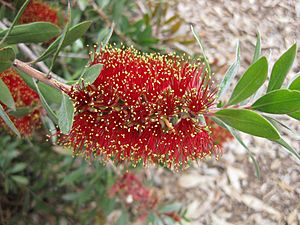Gold-tipped bottlebrush facts for kids
Quick facts for kids Gold-tipped bottlebrush |
|
|---|---|
 |
|
| M. polandii in Huntington Gardens, (Los Angeles). | |
| Scientific classification | |
| Genus: |
Melaleuca
|
| Species: |
polandii
|
| Synonyms | |
|
Callistemon polandii F.M.Bailey |
|
The Gold-tipped bottlebrush (scientific name: Melaleuca polandii) is a beautiful plant. It belongs to the myrtle family, called Myrtaceae. This plant grows naturally only in a small part of far northern Queensland, Australia. Some people still call it Callistemon polandii. It is a thick bush with new leaves that are a bronze color and feel a bit hairy. Its flowers are red with yellow tips, looking like a bottlebrush!
Contents
What it Looks Like
The Melaleuca polandii is a shrub that can grow up to 4 m (10 ft) (about 13 feet) tall. Its leaves grow one after another along the stem. They are about 63–129 mm (2–5 in) (2.5 to 5 inches) long. The leaves are also about 16–35 mm (0.6–1 in) (0.6 to 1.4 inches) wide. They are flat and shaped like a narrow egg, getting thinner towards the end. Each leaf has a clear main vein and many smaller veins (19 to 25 of them). When the leaves and branches are young, they are covered with fine, soft hairs.
The flowers are a bright red color. They grow in spikes at the ends of the branches. These branches keep growing even after the flowers bloom. Sometimes, flowers also grow where the upper leaves meet the stem. Each flower spike is about 50–60 mm (2.0–2.4 in) (2 to 2.4 inches) across. The petals are small, about 3.6–5.3 mm (0.1–0.2 in) (0.14 to 0.2 inches) long. They fall off as the flower gets older. Each flower has many stamens (35 to 50 of them), which are the parts that hold pollen.
Life Cycle and Reproduction
This plant usually flowers from late winter to summer. But sometimes, you might see flowers in other months too. After the flowers bloom, they turn into woody fruits. These fruits are called capsules. They are about 4.6–6.5 mm (0.2–0.3 in) (0.18 to 0.26 inches) long.
How it Got its Name
The scientific name Melaleuca polandii was first given in 2006 by a scientist named Lyndley Craven. He moved the plant from an older group, Callistemon polandii, to the Melaleuca group. The original name, Callistemon polandii, was officially described in 1902 by Frederick Manson Bailey. He found a sample of the plant collected by Reverend W. Poland near the Bloomfield River. The second part of the name, polandii, honors Wilhelm Poland. He was a missionary who worked in the area now known as Wujal Wujal.
Where it Grows
This type of melaleuca plant is found in the Cape Flattery and Cooktown areas of Queensland. It likes to grow in thick, sandy, or peaty soils. These areas are often called "wallum heath," which are special types of shrublands.
Using Gold-tipped Bottlebrush
The Melaleuca polandii is a strong plant that can grow well in gardens. It is especially good for warm areas near the coast. People often use it to create a screen or a hedge in their yards. It's important to plant it carefully, as its roots can be strong. It is best to avoid planting it too close to underground pipes.
Images for kids
-
M. polandii in Australian Botanic Garden Mount Annan


